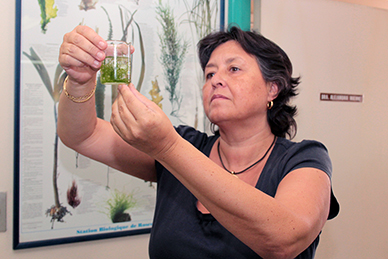- Researchers at the Faculty of Chemistry and Biology of Universidad de Santiago discovered the existence of functional TRP ion channels in the marine alga Ulva Compressa that are similar to the ones present at the nervous system in mammals and humans. “At first, it was difficult to imagine that these channels could exist in a marine alga, especially when they exist in mammals but not in terrestrial plants,” Dr Alejandra Moenne, researcher at the Department of Biology, says.
TRP channels are cellular sensors that detect and respond to different environmental stimuli, like temperature changes, pain and taste, what makes them key to many physiological processes.
“At first, it was difficult to imagine that these channels could exist in a marine alga, especially when they exist in mammals but not in terrestrial plants,” Dr Alejandra Moenne, researcher at the Department of Biology, says.
“Before having these results, we found that copper stress activates voltage dependent calcium channels (VDCC) similar to the ones present at the central nervous system of mammals. So, how the activation of voltage dependent channels was possible? We thought that the activation of VDCC depended on the previous activation of TRP channels, something difficult to imagine in a marine alga,” the researcher explains.
These results mean a change in the way how the physiological functioning of marine algae - organisms that have been present on Earth for about a thousand million years- is understood. They were published by the journal Frontiers in Plant Science in the paper "Copper-induced activation of TRP channels promotes extra cellular calcium entry, activation of CaMs and CDPKs, copper entry and membrane depolarization in Ulva compressa.”
The researcher explains that they not only found that “there are functional TRP channels that respond to copper but also that copper stress induces the release of amino acids and amino acid derived neurotransmitters similar to the ones released by human neurons. Even more, we have preliminary evidence that suggests that there is communication among different marine algae species through these molecules.”
Future research
In terms of research and to give answers to the new questions, Dr Moenne says that she intends to apply for a Proyecto Anillo together with researchers Juan Pablo García-Huidobro (Universidad de Santiago), Claudio Sáez (Universidad de Playa Ancha) and Erasmo Macaya (Universidad de Concepción), in order to deepen the knowledge on the communication among green, red and brown marine algae.
“As algae release amino acids and neurotransmitters- and have TRP channels and voltage dependent channels- algae functioning would be more and more similar to neurons, but with a slower response in minutes or hours, instead of the milliseconds of the neurons response,” she explains.
The paper "Copper-induced activation of TRP channels promotes extra cellular calcium entry, activation of CaMs and CDPKs, copper entry and membrane depolarization in Ulva compressa" (that received the recognition of the Editor of the journal Frontiers in Planet Science) was written by the research team of this project: Melissa Gómez, Alberto González, Claudio Sáez, Bernardo Morales and Alejandra Moenne. It is available online at http://journal.frontiersin.org/article/10.3389/fpls.2015.00182/abstract
Translated by Marcela Contreras



